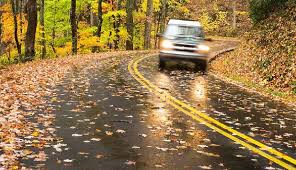 One of the most enjoyable seasons is upon us. The fall season is the start of the busiest, festive time of the year. Along with the fun holiday times, the weather begins to change from hot, sunny days to cold, rainy days; thus, the weather has a great impact on driving conditions. As the seasons change, many drivers fail to take precautions to maneuver throughout the roads. Statistics show that there is a 15% increase in automobile accidents due to the weather change. It is important for drivers to take extra precautions to avoid an accident especially if it causes stress for an individual during the holiday time.
One of the most enjoyable seasons is upon us. The fall season is the start of the busiest, festive time of the year. Along with the fun holiday times, the weather begins to change from hot, sunny days to cold, rainy days; thus, the weather has a great impact on driving conditions. As the seasons change, many drivers fail to take precautions to maneuver throughout the roads. Statistics show that there is a 15% increase in automobile accidents due to the weather change. It is important for drivers to take extra precautions to avoid an accident especially if it causes stress for an individual during the holiday time.
What dangers develop as the season changes?
• Rain. The fall introduces more rain in the forecast, which means wet roads have an impact on tires and if the tires are not able to handle the slippery roads it increases one’s chance to cause an accident. If the weather permits heavy rainfall for a day or more, it can create one to hydroplane. Hydroplaning can happen if one is driving as low as 30 mph on the road. When a situation like this occurs, it can be hard to brake of steer the car.
• Fog. As rain increases in the fall, so does the chance for fog. Fog consists of condensed water droplets that are cooled enough where the droplets can’t contain all of the water vapor. Rain will cool and moisten the air until the fog forms, which is why fog appears in the mornings after a night of rainfall. When fog does form regardless of the time of day, it can cause a driver to lose sight of the road. The Federal Highway Administration recorded that in 2016 fog caused about 2,500 auto accidents and 45 fatalities.
• Daylight savings time. In the fall, we gain 1 more hour of sleep. As a result, many people stay out later in the night especially on weekends and rely on the extra hour of sleep. This type of behavior can increase late night car accidents caused by alcohol consumption and driving while drowsy.
What can you do to increase your safety on the road?
1. Regarding fog, many people believe that turning on their high beams will help them see further, which is not true. One should turn on their low beams instead. Low beams decrease glare and it is helpful for the driver to keep a fair amount of distance behind the driver in front.
2. As one drives through the rainy weather conditions, it would be safe to watch your driving speed. It is best to drive at the speed limit because it is unpredictable how the roads will be after a period of rainfall.
3. Get enough sleep. It is essential to one’s day to get enough sleep to function throughout the day. Even though we gain 1 more hour of sleep, it does not mean that individuals can extend their evening hours more than necessary. NHTSA concluded that 48% of drowsy drivers nod off between the hours of 9 p.m. and 6 a.m.
The fact remains true that the change in weather can contribute to auto accidents. Unfortunately, the weather has a great impact on our driving skills. When individuals drive in areas they are not use to and the weather changes road conditions, there is an increase for an auto accident to occur. Eric Reyes and his litigation team have handled many cases with distracted drivers; thus, he is knowledgeable on how to pursue a client’s case. He is a Board Certified attorney in Personal Injury Trial Law and Civil law, so his experience with auto accident litigation can help one determine the value of their case. For further information or how to set up a consult, please give our office a call at (817) 332-1522
 Fort Worth Injury Attorney Blog
Fort Worth Injury Attorney Blog

